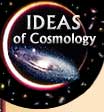
|
|
 |
How
Hubble Found Distances |

|
|
| Finding
distances to astronomical objects
had to be done through a series of steps. By the 1920s several big steps
had been taken, culminating in finding the distances to Cepheid variable
stars, which are bright enough to be seen from great distances. For it was
known that the period of variation of these stars could be used to calculate
their distances, as described previously.
Edwin Hubble used this method to measure distances directly
to 5 spiral nebulae in which individual Cepheids could be seen. A sixth
nebula, which was a physical companion of one of the first 5, he assumed
was at the same distance.
Knowing the distance to these 6 nebulae, Hubble could calculate the absolute magnitudes (that is, the actual brightness) of the brightest stars in them. He next assumed that the brightest stars in any nebula had this same absolute magnitude. From observations of the apparent magnitudes of the brightest stars in 14 more nebulae, Hubble estimated their distances. Now he could calculate an average absolute magnitude for the brightest stars in all 20 nebulae. Comparing this value with the apparent magnitudes of the stars in four nebulae in the still more distant Virgo Cluster of galaxies, he determined their distance too. Other spiral nebulae were too far away to observe any bright individual stars. Hubble picked 22 of these more distant nebulae and measured the apparent magnitude of the total light from each of them. He compared the average of these measurements to the mean absolute magnitude of the total light from each of the 24 nebulae whose distances he already knew. Assuming that on the average one set of nebulae gives out the same amount of light as any other, this gave him a mean distance for the farther 22. Now Hubble had enough data for his landmark 1929 paper, in which he first established the velocity-distance relation. |
|
Copyright ©. Brought to you by the Center for History of Physics, a Division of the American Institute of Physics |
|
|||||